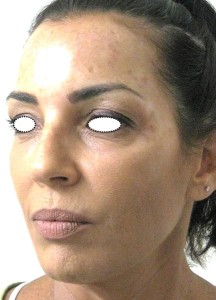Reports
Combination Therapy that consists of Calcium Hydroxyapatite (CaHA) and Hyaluronic Acid (HA) is the next generation of aesthetic treatment
Dr. David Mor-Yosef, aesthetic physician, an international lecturer and a clinical advisor in the aesthetic medicine field, has 10 years of experience in aesthetic medicine. Dr. Mor-Yosef has a vast experience in the new emerging aesthetic medicine application of dermal fillers combination and considered to be one of the skilled authority in Micro-Invasive Face Sculpturing.

דוקטור דוד מור יוסף מומחה לרפואה אסתטית מחיפה במהלך טיפול בוטוקס המצולמת הסכימה להצטלם וחתמה על אישור 23 פברואר 2015 צילום: גיל אליהו-ג׳יני
“Patients who arrive at my clinic are in need of aesthetic medical treatments, smoothing folds and wrinkles and facial proportion adjustments. I have experienced many products available on the market, such as HA fillers and different collagen generators: CaHA, Collagen, PCL, PLLA, PMMA, PEG and even Silicone, and found that the best results can be achieved when combining HA with CaHA – a potent collagen stimulator. Of course, this all depends on the treated area and patient’s characteristics.
HA based dermal fillers are today’s most popular and wildly used products. CaHA based fillers, although in the market for almost as long as HA fillers, have a market share that only reaches ~10%. This is surprising considering the many advantages of the product, such as the ability to generate new collagen, give long lasting results, high lifting capacity and possible sculpturing applications. The unjustified prejudice regarding CaHA, which is based on old information and wrong assumptions, such as high occurrence of side effects, granulomas and lumps formation, inability to inject it too superficially or to every anatomical location, in addition to the inability to dissolve the product once injected, and at last the product high market price, leads to product use abstention.
In recent years, we are experiencing a rise in the use of collagen generating fillers combined with HA. This is based on the understanding that HA fillers, by themselves, induce only small amount of collagen fibers and tissue lift. This new trend, however, does not involve active mixing of two products. Combinations of products were discussed in temporal or anatomic relationships. Temporal combinations refer to the use of different fillers at different times and anatomic combinations refer to the use of different fillers in different parts of the face. One of the main reasons for this is that currently there is no documented clinical experience for any mixing procedure, as a matter of fact; most manufacturers do not recommend mixing different products in the same injection sites.
When I first started to use Luminera’s line of products, I took advantage of the full range offered, and started to mix the HA line “Hydryalix” with the CaHA “Crystalys“. By mixing I do not mean in a temporal or anatomical relationship but mixing the material in the same syringe and actually creating a “cocktail” combining HA and CaHA. After experiencing several different protocols, I found that in most areas a 50% HA and 50% CaHA mix is preferable. The exact concentrations of each product can vary from one patient to another, depending on the patient’s age, skin thickness and texture, wrinkle severity and volume needed to replenish.
In order to prepare the mixture I empty “Crystalys” syringe and “Hydryalix” syringe, using a Luer-lock connector, into a 5ml empty syringe, then I plug another 5ml empty syringe. After assuring a firm connection, I transfer the two gels from one syringe to the other, at least 10 times, in order to achieve full homogeneity. The mixed filler combines the advantages of the HA and the CaHA microspheres thus enhancing the tissue filling and lifting effect. “Hydryalix” has five different presentations, and for each treatment area, I choose the relevant type, for example, when treating the marionette lines, or nasolabial folds, I would use a mix of “Crystalys” and “Hydryalix Deep“, for the cheek bones and chin area I would recommend using “Crystalys” and “Hydryalix Ultra Deep“.
The advantages of the combination between HA and CaHA are well established in the literature. While HA alone, gives relatively short term results, and does not generate a real lifting effect, and on the other hand, CaHA fails to give immediate results, and cannot be dissolved when needed, the combination gives a complementary and synergistic effect in terms of collagen generation resulting in longer lasting outcomes. While CaHA stimulates new natural collagen production, HA binds to fibrin to form a supporting extracellular matrix, which modulates fibroblasts proliferation and collagen formation. The combination enhances the beneficial effect of each product separately. In addition the presence of the HA prevents CaHA microspheres aggregation on the one hand, reducing the risk of granulomas formation, and maintains microspheres consolidation thus preventing their dissemination, on the other hand. The procedure is safe and easy generating immediate and long lasting constant results.”
Dr. David Mor-Yosef MD, an aesthetic medical practitioner for the last 10 years, graduated with Deans Honor, the Technion’s Faculty of Medicine. Worked as a medical director at EZ-surgical Bio-Medical start-up where he helped developing a number of medical device patents in the laparoscopic surgery field. Dr. Mor-Yosef worked as a medical affairs consultant, performing clinical studies worldwide at Novartis International AG, a Swiss multinational pharmaceutical company. Dr. Mor-Yosef is the director of private medical aesthetics clinics in Israel serving elite aesthetic medicine to his clients, always using the latest technologies and the highest quality materials.
Dr. Mor-Yosef is one of the leading aesthetic physicians in Israel, with a vast record of national and international lectures and masterclasses. He masters the techniques of Non-Surgical Face Sculpturing: Non-Surgical Rhinoplasty (nose sculpture), Mental (chin) Enhancement, Zygomatic (Cheekbones) Augmentation, Mandibular (jaw-line) body Restoration, Glabellar (Eye Brow Ridge) Bossing etc.





